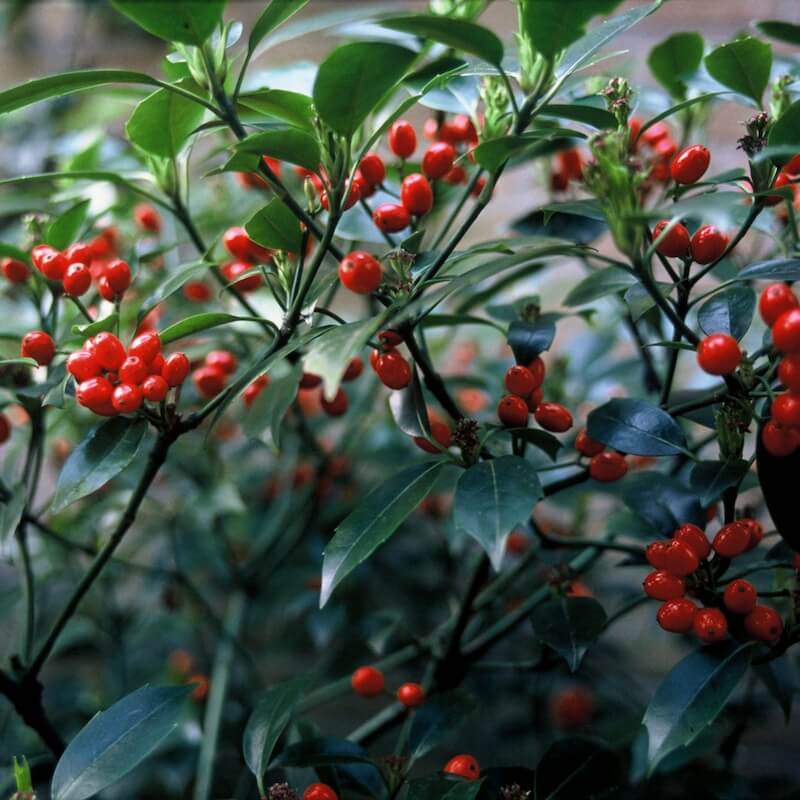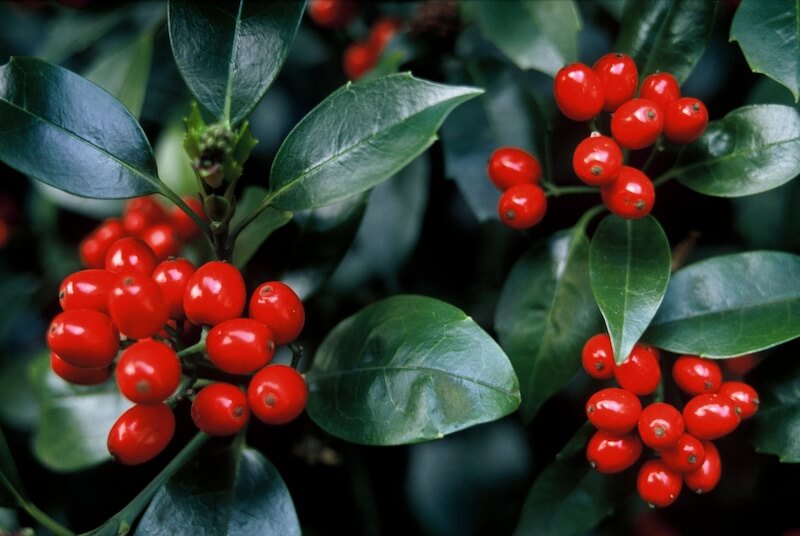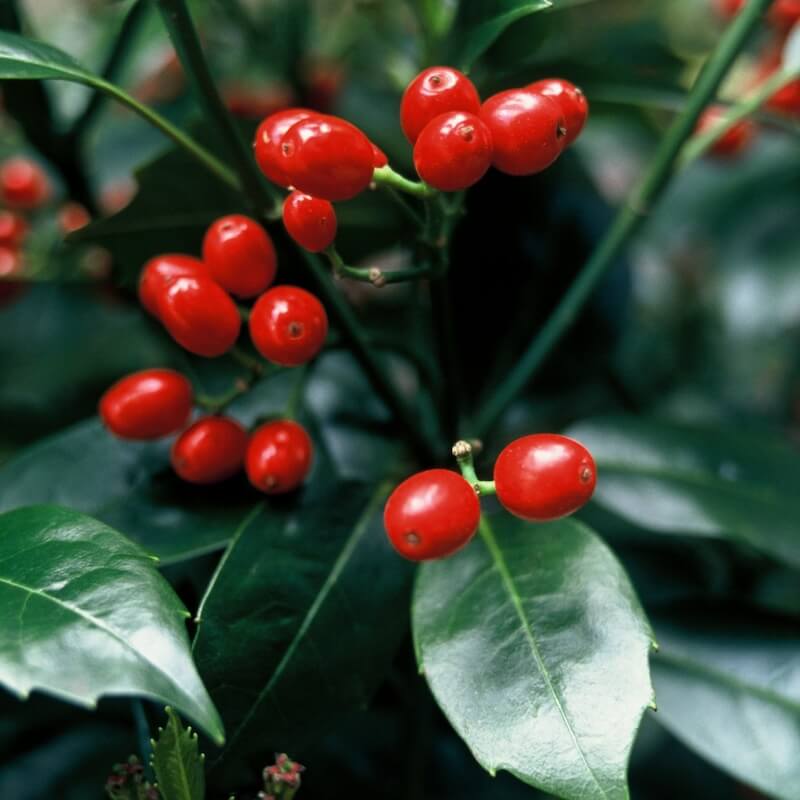
Position
- Thrives in partial to deep shade, ideal for north or east-facing gardens, spaces beneath trees, or shady corners
- Will tolerate full shade, making it excellent for challenging, low-light locations
- Prefers shelter from cold, drying winds to prevent leaf damage
Hardiness
- Hardy down to around –15°C (5°F)
- Copes well with typical UK winters and is reliable in most regions
Soil
- Grows best in fertile, moist but well-drained soils
- Versatile, tolerates clay and sandy soils if improved with compost or well-rotted manure
- Dislikes persistent waterlogging but manages most other conditions well
- Happy in acid, neutral, or alkaline soils
- Adapts well across the full range of UK garden soils, provided drainage is sufficient
- Grab a soil test kit and ensure the perfect conditions for growth
Height
- Usually reaches 1–1.5 metres (3–5 feet) after 5–10 years
- Develops into a dense, rounded, evergreen shrub well-suited to smaller spaces or containers
Seasons of Interest
Additional Notes
- Prune lightly in spring to shape or remove any damaged or old branches—responds well to cutting back if needed
- Mulch annually in spring with compost to conserve moisture and support growth
- Water well during dry spells, especially when newly planted or container-grown
- Exceptionally tolerant of urban pollution and shaded city gardens
- Pest and disease resistant, requiring little attention once established
- Compact habit makes it suitable for containers, low hedging, or mass planting in shade
- This variety isn’t monoecious (self-fertile) as often stated
Aucuba japonica Rozannie - Evergreen Colour, Year-Round Structure
Aucuba japonica Rozannie is a compact, evergreen shrub that brings structure, glossy green colour, and seasonal interest to even the smallest garden spaces. A form of Japanese laurel, Rozannie is prized for its dense foliage, ability to thrive in deep shade, and bright red berries that appear in autumn.
What makes Aucuba japonica Rozannie such a brilliant garden choice?
Rozannie is a compact, evergreen shrub characterised by its glossy, dark green leaves. It stays neat and bushy, making it a perfect option for small spaces and shaded borders.
This hardy evergreen grows to around 120–150cm tall and wide, forming a dense mound of foliage that works beautifully in mixed borders, shady courtyards, or as a specimen in a container. It tolerates sun or shade and is especially useful in those tricky spots where other plants struggle. With year-round foliage and seasonal colour from flowers and fruit, it’s a great all-rounder.
How does Aucuba japonica Rozannie perform in different garden settings?
Whether you’re working with a small shady site, an exposed urban front garden, or a north-facing courtyard, Rozannie can slot in with ease. This versatile shrub, with its glossy, dark green leaves, holds its colour all year, providing contrast and structure even through winter.
Rozannie grows well in beds, borders, and containers. In larger spaces, it’s ideal for creating informal low hedges. In more compact settings, it can serve as a tidy, low-maintenance feature plant. Its hardiness, glossy foliage, and self-contained size make it a strong performer across a wide range of garden settings.

What are Rozannie’s flowering and fruiting habits?
Rozannie produces small, modest flowers in spring. These usually appear around April and May, forming tight clusters that are easily missed among the foliage. These are followed by bright red berries that ripen in autumn and persist into winter.
The berries are a real highlight, and because Rozannie is a female shrub, it requires a male aucuba nearby to produce berries. Flowers followed by berries add seasonal interest and support wildlife in the colder months.
How tall and wide does Aucuba japonica Rozannie grow?
Rozannie typically reaches a height of 100–150cm, with a similar spread. This makes it ideal for smaller gardens, where its compact habit ensures a tidy appearance without constant pruning. It maintains a naturally rounded, bushy shape and won’t sprawl or become leggy in shade.
This growth habit makes Rozannie ideal as an informal hedge or edging shrub. You can also let it shine as a focal point in a mixed border. Its dense, dark green leaves provide texture and structure without overwhelming neighbouring plants.
What soil does Rozannie prefer?
Rozannie prefers well-drained soil enriched with organic matter. It’s not fussy about pH, and it tolerates a wide range of soil types. To get the best from this shrub, add a mulch of well-rotted garden compost or manure around the base in spring.
This annual mulch improves moisture retention and feeds the roots as it breaks down. It also supports bushy growth and helps Rozannie look its best year-round. Avoid heavy, waterlogged soil—this plant likes its roots to breathe, especially through the colder months.
Can Rozannie tolerate dry shade?
Yes—one of Rozannie’s key strengths is its ability to thrive in dry shade. This makes it a brilliant choice for underplanting around trees, positioning near north-facing walls, or adding structure beneath taller shrubs.
Many plants struggle in these conditions, but Rozannie handles them well once established. Give it a good start with enriched soil and mulch, and water it regularly in the first year. After that, it becomes a low-maintenance fixture that brings consistency and colour to difficult spots.
How should you prune Aucuba japonica Rozannie?
Rozannie is naturally compact and rarely needs heavy pruning. However, you can tidy it up or reshape it in spring after flowering. This is the ideal time to remove any straggly branches or damaged stems, encouraging fresh growth.
To maintain its shape, prune lightly just after flowering. Avoid cutting back too hard, especially late in the season, as this could reduce berry production. Always prune just above a healthy bud and try to maintain the shrub’s rounded form.
Is Rozannie a good option for hedges or screening?
Rozannie is an excellent plant for informal hedges or low screening. Its dense, glossy foliage provides year-round cover, and its modest height makes it ideal for use as a boundary without blocking light. You can space plants around 60cm apart to create a continuous hedge.
Because Rozannie is low maintenance and produces berries in the Autumn, it works well in wildlife-friendly borders. The berries serve as a food source for birds, and the evergreen foliage provides shelter. It also tolerates pruning well, making it easy to maintain a neat appearance without frequent intervention.
Where can you buy Aucuba japonica Rozannie?
You can find Rozannie at most well-stocked garden centres or order it directly from an online nursery. If you’re shopping in person, look for glossy, dark green leaves and signs of healthy growth. When selecting your plant, choose one with well-developed foliage and a bushy shape. Once planted, Rozannie establishes quickly and becomes a reliable feature in your garden. If you’re looking to buy aucuba for shade or structural planting, Rozannie is a top choice.
How low maintenance is Rozannie really?
Rozannie is as low-maintenance as shrubs come. Once established, it requires little more than an annual mulch, the occasional pruning, and regular watering during dry spells. It’s hardy, tolerant of shade, and keeps its foliage neat with very little input.
This evergreen shrub, with its glossy, dark green leaves, adds long-lasting value to any planting scheme. Whether you’re a beginner gardener or an experienced grower looking to reduce upkeep, Rozannie brings beauty and structure with minimal fuss.
From Darren’s Patch
Rozannie is one of those plants I consistently recommend to friends and clients looking to brighten a shady corner with minimal effort. Although I’m not currently growing it in my garden, I’ve used it in past designs where its dense, glossy foliage and reliable structure worked beautifully in awkward, low-light spots. It’s incredibly versatile—happy under trees, against north-facing walls, or tucked into a courtyard container. I also appreciate how low-maintenance it is; once established, it simply gets on with the job, providing year-round interest with very little fuss. If you’ve got a tricky shaded area and want something reliable and attractive, Rozannie is a dependable go-to.
![]()
Key Points to Remember
- Compact evergreen shrub with glossy dark green foliage that stays attractive all year
- Perfect for small shady sites, north-facing gardens, and tricky areas under trees
- Grows to a height of 100–150cm, forming a neat, bushy growth habit
- Thrives in sun or shade and is tolerant of dry shade once established
- Needs well-drained soil enriched with mulch of well-rotted garden compost or manure
- Requires minimal pruning—remove straggly branches in spring to shape and refresh growth
- Ideal for hedges, borders, containers, or as a structural plant in shaded spaces
- Available in most garden centres and online nurseries
- A reliable, low-maintenance solution for year-round structure and seasonal colour
Aucuba japonica Rozannie excels in partial to full shade, in moist but well-drained, improved soil of any pH, and is hardy down to –15°C (5°F). Reaching 1–1.5 m (3–5 ft) in 5–10 years, it forms a neat, compact, evergreen shrub with glossy green leaves and produces red berries without the need for a nearby male plant. With annual soil improvement, spring mulching, and simple pruning, ‘Rozannie’ is a trouble-free, versatile shrub perfect for smaller gardens, shaded areas, and containers in the UK.
Want to learn about other shrub varieties? Read about Aucuba japonica Picturata here.
For more information on Shrubs for your garden, please click here.

Frequently Asked Questions
Q: What is Aucuba japonica Rozannie?
A: Aucuba japonica Rozannie is a compact evergreen shrub, known for its glossy dark green leaves and bright red berries. A female form of the Japanese laurel, Rozannie is valued for its bushy habit and suitability as a shade plant. It typically grows to around 1–1.5 metres tall and wide, making it ideal for smaller gardens or shaded borders. With its year-round interest and tolerance of dry shade, Rozannie is a reliable and low-maintenance choice for UK gardens, particularly where other plants may struggle.
Q: Where is the best place to plant Aucuba japonica Rozannie?
A: Aucuba japonica Rozannie prefers a sheltered spot in partial to full shade. It performs well under trees, in north-facing borders, or along shady fences. Avoid exposed, sun-scorched positions, as harsh sunlight may scorch its foliage. This shrub thrives in moist but well-drained soil and is particularly tolerant of dry shade once established. Whether planted as a specimen or as part of a mixed evergreen border, Rozannie is remarkably versatile and thrives in areas where many other plants may struggle.
Q: What kind of soil does Aucuba Rozannie need?
A: Rozannie is adaptable to a wide range of soil types, provided they are moist and well-drained. It tolerates acidic, neutral, and alkaline conditions and can thrive in both clay and sandy soils. For best results, improve the planting area with a mulch of well-rotted garden compost or manure around the base. This helps retain moisture and enriches the soil for healthy, bushy growth. While tolerant of poorer soils, Rozannie will flourish in organically rich conditions.
Q: How hardy is Aucuba japonica Rozannie in the UK?
A: Aucuba japonica Rozannie is reliably hardy throughout most of the UK, tolerating temperatures down to approximately -15°C (5°F). Its leathery, glossy foliage holds well through winter, maintaining year-round structure and colour. In more exposed or frost-prone locations, a sheltered position is advisable. Its cold resistance, coupled with drought tolerance once established, makes Rozannie a remarkably resilient choice for shaded and urban gardens alike.
Q: When does Rozannie flower and produce berries?
A: Small clusters of dark purple flowers typically appear in April and May, often nestled in the leaf axils. As Rozannie is a female form of aucuba, flowers are followed by bright red berries in autumn, provided a male aucuba is growing nearby to ensure pollination. These ornamental berries persist into winter and are attractive to birds, enhancing the shrub’s wildlife value and visual interest through the colder months.
Q: Does Aucuba Rozannie need pruning?
A: Rozannie is a low-maintenance plant that rarely needs pruning. However, to maintain its neat shape or to remove any straggly branches, you may prune lightly in spring. Aim to trim just after flowering to avoid compromising berry production. Any damaged or congested growth can be removed at the same time. To encourage bushier growth, cut back leggy stems just above a leaf node and feed the plant after pruning with a balanced shrub feed.
Q: How should I feed and mulch Aucuba Rozannie?
A: Feed Aucuba Rozannie in spring using a general-purpose slow-release shrub feed. This supports lush foliage and healthy berry production. Additionally, apply a mulch of well-rotted garden compost or manure around the base to improve moisture retention and enrich the soil. Avoid piling mulch against the stems, and refresh it annually for ongoing benefit. This combination of feeding and mulching promotes strong, resilient growth and glossy, deep green foliage throughout the year.
Q: Is Rozannie suitable for hedging or containers?
A: Yes, Rozannie makes an excellent low hedge or backdrop for shade planting schemes due to its dense, evergreen habit. It also performs well in large containers, where its compact size and shade tolerance can be fully appreciated. Ensure pots have adequate drainage and are filled with good-quality compost. Container-grown specimens benefit from regular feeding during the growing season and should be repotted or refreshed every few years to maintain optimal growth.
Q: Where can I buy Aucuba japonica Rozannie?
A: Aucuba japonica Rozannie is widely available in the UK from reputable garden centres, plant nurseries, and online retailers. Whether you’re looking for a potted specimen for shade, a compact hedge plant, or something to brighten a dark corner, Rozannie is a popular and readily accessible choice for both novice and experienced gardeners.
